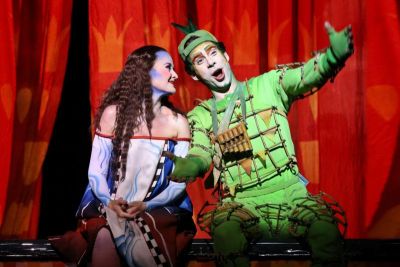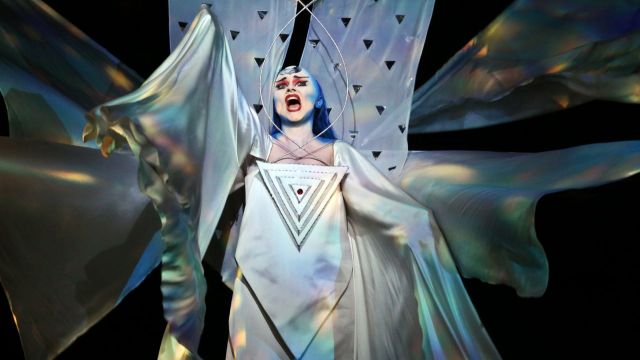The Magic Flute
The opportunity to see two very different Opera Australia productions of The Magic Flute in a matter of months was something not to be missed. In the first, The Magic Flute on Tour, Australian idiom, Egyptian Mysteries, wonderful voices and a chorus of local children took Mozart’s appealing music and characters to multiple venues and audiences around the country. It was fun, entertaining, beautifully directed and performed, educational … but just a little bit ‘twee’.
Not so this 2015 production based on that created and directed by Julie Taymor (The Lion King) for the Metropolitan Opera of New York in 2005. There is all one might expect of Taymor’s imagination meeting Mozart’s symbolism and magic. There are brightly coloured and intricately designed costumes and make-up, giant puppets and flying birds (brilliantly manipulated by a small army of blue-faced and blue-costumed puppeteers) and a huge perspex set hung about with screens and backdrops that pick up on some of the symbols and ideals of freemasonry interspersed in both the music and themes of the opera.
The Magic Flute is a tale about “reason and wisdom, trials and enlightenment”, and the power of love, told through music that picks up each of the characters with specific rhythms, notes and instruments that tell as much about their personality as the words they sing.

The Queen of the Night, for instance, is beautiful, but the notes of her arias, high-pitched and staccato, belie the truth of her character. Emma Matthews finds all of this manipulative coldness yet compelling power as she reaches, seemingly easily, to the incredibly high notes that Mozart used to expose the true character of the scheming queen.
In contrast, the characters of Tamino and Pamina are open and relatively uncomplicated, albeit each falls in love with a picture and an ideal! John Longmuir is steadfast as Tamino, his voice building from initial fear, to concern, passion and a final ringing realisation of his quest and his love.
Taryn Fiebig is equally passionate as Pamina, but is given the opportunity by Mozart to be a little lighter at times, as in her duet with Papageno, where the two trip across the stage in a banter of notes and words that combines the musical themes that denote their characters and their plight. Fiebig moves lightly on the stage and portrays her character clearly, especially in Act II, where, seemingly rejected by Tamino, she contemplates suicide in an aria that is filled with despair.
As Papageno, Samuel Dundas continues to impress with voice, lightness on the stage and characterisation. He makes Papageno appealingly awkward and funny in all his connections with other characters, good and bad, and his birds.
 The Brotherhood, to which Tamino aspires and Pamina feels she needs to escape, is depicted by the chorus in two startling sets of costumes, one black and white, the other the gold of final resolution. Their leader, Sarastro, the voice of enlightenment, is played with contained power and very low, sustained notes, by Daniel Sumegi.
The Brotherhood, to which Tamino aspires and Pamina feels she needs to escape, is depicted by the chorus in two startling sets of costumes, one black and white, the other the gold of final resolution. Their leader, Sarastro, the voice of enlightenment, is played with contained power and very low, sustained notes, by Daniel Sumegi.
In contrast to Sarastro’s calm, still authority is the lecherous character of Monostatos, played in this production with libidinous energy by Kanen Breen. In a grotesque make up and body suit, he flits about the stage, light of foot, clear of voice, evil of intent!
Colour, texture and imagination pervade the music of The Magic Flute. Taymor’s design, Matthew Barclay’s direction and the orchestra under the baton of Anthony Legge have picked up on all each of these and all the possibilities that that might be suggested by Mozart’s themes
Enormous puppets either dwarf the performers or flit around them. The ladies of the Queen of the Night, blue-faced like the puppeteers, wear huge masked headpieces which depict different emotions. Their blue is picked up the Queen’s hair and around her face and Pamina’s face and costume. Characters and costumes harmonise as intricately as their musical themes, making this production as entertaining today as it must have been when it first played in Vienna in 1791.
Carol Wimmer
Photographer: Prudence Upton.
Subscribe to our E-Newsletter, buy our latest print edition or find a Performing Arts book at Book Nook.

